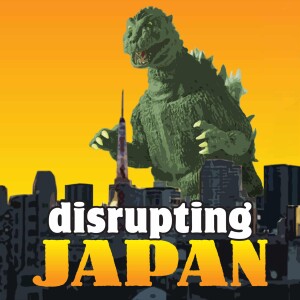
Disrupting Japan: Startups and Venture Capital in Japan
Business:Entrepreneurship

How Japanese graffiti Is sneaking onto the blockchain
 2023-05-01
2023-05-01
Download
Right click and do "save link as"
Graffiti is impermanent.
Normally, thats a good thing, but as the global art world has begun to recognize graffiti and street art as a legitimate art form, the short-term and public nature of street art has presented challenges around sales and ownership.
The team at Totomo has found a solution. They have been working with street artists around the world and galleries across Tokyo to create a platform to prove digital ownership of street art.
We talk about the challenges of bringing digital tools and provenance into the spray-can world of street art, why this international team decided to launch in Japan first, and how to take advantage of the new startup support programs offered by the Shibuya government.
It's a great conversation, and I think you'll enjoy it.
Show Notes
The challenges involved in monetizing street art
Is street art "legitimate", and how world opinion is changing
Why Japan views street art differently
Why Totomo is not using the standard NFT marketing strategy
The importance of real-world gallery events
Why most Totomo NFTs are not bought using crypto
Do NFTs really pay artists on resale?
Bailing an artist out of jail
How attitudes to street art are changing in Japan
The real reason Totomo launched in Japan first
How a foreign-run startups can raise money from the Japanese government
Links from the Founders
Totemo Street Art NFT Gallery
Street Art Collector podcast
Follow Totemo on Twitter @totemoart
See some great street art
Check it out on Instagram
Street art on YouTube
Transcript
Welcome to Disrupting Japan. Straight Talk from Japan's most successful entrepreneurs.
I'm Tim Romero and thanks for joining me.
Today we're going to talk about NFTs and no, no, it's not what you think. Regular listeners know that I'm an NFT skeptic, but being an honest skeptic means keeping an open mind. And in that spirit, I'd like to introduce you to the team at Totemo because they're doing some genuinely interesting things with graffiti, street art and the block chain.
They're helping artists get paid and as far as I'm concerned, that's always a worthy activity.
So, today we sit down for a four-way conversation with the Totemo team of Marty Roberts, Elena Calderon Alvarez and Minami Kobayashi. We talk about why Totemo decided to target their business much more tightly on the art community than on the crypto community. and also why this international team who represents international artists, decided to launch their startup in Japan.
We talk about how graffiti and street art are becoming accepted as mainstream art around the world and the amazing level of support that the Shibuya government is providing startups these days and whether bailing your clients out of jail is a good use of investor capital.
But you know, the Totemo team tells that story much better than I can. So, let's get right to the interview.
Interview
Tim: So, I'm sitting here with the founders of Totemo. Marty, thanks for joining us.
Marty: Thanks so much Tim for having us.
Tim: It’s good to have you back. And Elena.
Elena: Hi. Thank you for having us.
Tim: It's good to have you on and Minami.
Minami: Hi.. Thank you for having us.
Tim: It's great to have you on. I don't usually have three people on the show, but making an exception this time because what you guys are doing is really interesting. You're bringing street art and graffiti art to the blockchain, but I think you can probably explain it a little better than I just did. So, what exactly does Totemo do?
Marty: Yeah, yeah, I think you summed it up quite well already, but the point that we're trying to work on is that right now graffiti and street art, while it's loved by many around the world, it's impermanent and eventually it will be destroyed by the elements, by the government, by other graffiti writers. So, if there was a way to make this permanent and also collectable and tradable,
view more
More Episodes
One way to unlock Japan’s broken e-commerce
 2023-02-06
2023-02-06
 2023-02-06
2023-02-06
Why medical AI is taking off in SE Asia
 2022-11-07
2022-11-07
 2022-11-07
2022-11-07
The dangerous defect in most SaaS startups
 2022-07-11
2022-07-11
 2022-07-11
2022-07-11
How do you know if your startup idea is bad?
 2022-03-21
2022-03-21
 2022-03-21
2022-03-21
Passion alone can’t make cars fly
 2021-12-20
2021-12-20
 2021-12-20
2021-12-20
02345678910111213141516171819
Create your
podcast in
minutes
- Full-featured podcast site
- Unlimited storage and bandwidth
- Comprehensive podcast stats
- Distribute to Apple Podcasts, Spotify, and more
- Make money with your podcast
It is Free
- Privacy Policy
- Cookie Policy
- Terms of Use
- Consent Preferences
- Copyright © 2015-2024 Podbean.com




